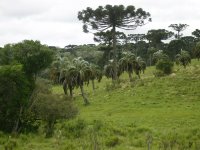Posted:November 24, 2006
Butia Eriospatha by Nigel kembrey
 Hardy Palms for the UK.
Hardy Palms for the UK.For the last 20 years or so, during our recent warm British winters , several palms from South America have been thriving. The most well known is Butia capitata , a large feather palm which has been growing in Southern France, Italy and the USA for 100 years. In our more recent winters it has thrived in the UK, shrugging off frost and snow. In our climate however, it is fairly slow growing. More recently, Butia yatay has been introduced from Argentina and seems slower than Butia capitata.
It is obvious that provenance plays a part in a palms performance, so last year I went to Southern Brazil to try and resolve some unanswered questions re Butia species, and to see in habitat some of the palms that grow here in our Northern European gardens.
For me, the questions I wanted answered were;
What is the climate REALLY like in Southern Brazil?
Which species of Butia will grow best in the UK.
Our journey was not an easy one, Southern Brazil is not easily accessible nor tourist orientated and it is a long way to travel with 2 connections. We did not know what to expect, South America has something of a reputation, the pictures you see on TV often portray Brazil as a country of burning forests and poverty. In fact we were pleasantly surprised , Southern Brazil is relatively unspoilt with much of the rainforest intact , the towns and cities are very European in feeling, and the people the friendliest and most hospitable I have ever encountered.
Within minutes of arriving in Curitiba we were able to see native palms nearby, and the drive to our hotel near the coast ,whilst conducted in darkness still revealed an amazing number of palms of various species growing wild alongside the road.
The climate is not what we imagined it to be. Contrary to popular belief, the lowland areas where many of the Butia species grow tend to be frost free. The areas along the coast of Southern Brazil do not see severe frosts in winter and remain above freezing. In some places the temperature does not drop below 10C in winter. Much of the lowland Butia capitata habitat where we visited was heavily populated with tropical palms, a sure sign that frosts did not occur.
Our first trip was from the coast where the temperature was hovering around 30C , back up to our point of arrival, Curitiba. This is a large city with a population of over 1 million people , sitting at 1000m above sea level and more than an hour from the coast. As we progressed upwards from the coast the change in climate was considerable. First it was noticeable that at about 400m above sea level the bountiful tropical palms that previously grew everywhere like weeds were suddenly absent.
The vegetation was changing considerably and we began noticing many plants common to Northern Europe growing wild on the edges of the road, together with more conifers. Cloud seemed much more prevalent here , the area often submerged under cloud , with awesome monkey puzzle trees (Araucaria angustifolia) looming above the forest skyline.
Soon we saw our first Butia eriospathas, these were immense Butias with huge trunks and crowns far bigger, greener and more beautiful than the average Butia capitata. Every house seemed to have its own Butia eriospatha in the front garden.
We finally parked the car to inspect some large trees growing wild in the hedgerow. As we stepped out of the car the difference in climate hit us. There was a breeze blowing, it was drizzling with rain and the temperature was COOL. In fact it felt just like a typical English summers day, completely at odds with the climate lower down where Butia capitata was found.
This weather is quite normal for Curitiba in summer, and we discovered that winter is quite cold and wet with temperatures commonly as low as -3C or -4C and can go as low as -6C. All around we could see Dicksonia sellowiana, a tree fern very like Dicksonia antartica and known to be equally as hardy. The evidence of cold was there, brown frost damaged fronds hanging down and the plants flushing with new green fronds.
We had found the biggest and most beautiful Butias we had ever seen and they were growing in a climate similar to our own !
Having answered one of our initial questions it immediately begged another that we could not answer…..
Why oh why are we not all planting a Butia eriospatha in our gardens like the people on the Brazilian tablelands when our climate is so similar.
Since last year I have grown Butia eriospatha here , the palms have not disappointed me, growing with considerable speed unlike most other Butias. It seems the UK is set to become the second home of Butia eriospatha. Posted by: Nigel Kembrey 20/11/2006
copyright© 2006 Nigel Kembrey




